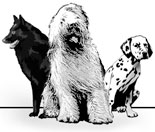Bing Blog #13
| Amazing Friends -- February 4, 2006 I have the most amazing friends!!! I decided at long last that I needed the expert opinion, advice and input of my friend Leslie McDevitt regarding Bing. On Tuesday, Bing and I went to visit with her, and I filled her in on his issues: the ear infection, his eye getting squirted with hose and subsequent reluctance to have people touch him, his noisiness in the crate, and his noisiness in the car crate. Through our discussion, we agreed that Bing has a low threshold for frustration, that he has some weird space issues, and that he has learned that using his mouth to make things go away works. Some examples of the space issue are: he sits almost 5 feet away from me when I work on Loose Leash Walking or Heel. He doesn't like being confined to a crate; when we go out and he has to be in his crate he is usually very good about it, but he really dislikes being in there at night or when we are home. As a matter of fact, he took himself out of the crate at night by 5 months (and has been fine). He has issues with the hatch coming down on the car. People coming toward him are of issue if he thinks they are going to mess with his head (physically). On the other hand, having him sit at heel with him between me and a wall hasn't been a problem...it started out being difficult for him but it doesn’t bother him at all now. However, this is the only way I can get him to sit straight for me so far (a sign that I haven’t quite done enough work with him yet!). So...what to do. Leslie suggested that I begin to practice Karen Overall’s relaxation protocol with a Leslie McDevitt twist! The relaxation protocol involves having the dog practice a sit stay or down stay on a mat or bed. But it’s not JUST a stay; the person rewards physical signs of relaxation, such as blinking, yawning, exhaling, putting the head down, rolling the hip. Leslie wants me to blink my eyes as if they are getting heavy, and reward him when he mirrors this. Over time, we expect that he will start to offer ‘gooey eyes’. Once we can elicit the calm behavior we will begin to add distractions and reward when the dog remains calm. Eventually, one of the distractions will be hands coming near him. This process will have the long-term effect of teaching Bing how to calm himself down when he’s overexcited, how to learn to think when he’s aroused, and how to take cues from me when he’s aroused. Basically it will help him learn how to focus under any circumstance. Wow! What an excellent concept for any dog! We also talked about how happy he is all the time, how excited he his to work and to learn, and how wound up he gets in the process. Leslie suggested that I work on rewarding a CLOSED MOUTH hand target. Great idea! Bing’s mouth is wide open when he touches, and this is definitely not a calm behavior! Bing learned to hand target before he even knew his name, and he will offer a target to just about anything. Since this is such an ingrained behavior, I will teach him a new behavior of touching a target with his mouth closed, adding a new word to it, which I can then transfer eventually to a hand or whatever I want to transfer it to. This will also come in handy for contacts in agility. (It hasn't been all that long since we have totally disallowed mouthing at all, other than when he 'holds' my wrist in his mouth when he's extremely calm, like a pacifier). I also need to work individually on each freeshaped thing I've been working on, like paw on knee, shout, relax, and head down...and focus on labeling them, which I haven't been doing. The reason this is important is that, like I said, he LOVES to work and gets very excited. When I begin to work with him, he offers all of the behaviors on which we have been working, and if I don’t reward them, he becomes frantic. A frantic dog is not a relaxed dog! So I need to be able to ask for the behaviors when I want them, so we have a better understanding between us. In addition, we will implement the typical 'implied sit' for everything. Everything...but a sit with gooey eyes....c-a-l-m.... Of course, this can only start to happen once it’s been taught in isolation and then generalized. We will also start teaching a new cue for 'Ooo! Look! A person is walking up to us!'...that will be the cue for him that he's going to eat from my hand while the person comes near him for a microsecond and then come away with me. In this manner, we can start setting up for the eventuality that people are going to want to come up and pet him. I can start to do this with Pete, then with his friend Jack, who’s here fairly regularly, then generalize it to other familiar people. I will need to come up with a verbal cue for this, and have the visiting person exist for a very short period of time, increasing the duration and intensity over time. I will also teach him a cue that means the interaction is over and we are going to exit the situation. This is extremely important because one of Bing’s most worrisome behaviors is to give an air snap when a person is petting him and he’s had enough. This doesn’t only happen when a person initiates the petting; it occurs when HE solicits attention and petting, and then suddenly decides he’s had enough. This apparently is pretty common in herding dogs, but of course it isn’t appropriate. By teaching a cue that the interaction is now ending and we are disappearing, I take control of the situation out of his paws and put it in my hands, have him pay attention to me and follow me, take the anxiety off of him, and prevent the air snap from occurring. This means that he will not feel that he has to air snap, and will trust in me that I won’t let people touch him. Tugging is a game that he loves, and he often presents us with a tug toy. It’s a great bonding game, and it will be great for agility. But he only does it in the house, so I need to help him generalize it everywhere. I also will want to have him get excited and tug, and then ask him for his relax pose/gooey eyes, then tug again, then ask for his relax pose/gooey eyes. This will be like teaching him and on/off button! I will be able to ask for his relax pose regardless of where he is or what he’s doing, whether it’s tugging, playing with Acacia, retrieving a tennis ball, or running in the woods. Finally, we will want to play ‘hand games’ with Bing to prepare him for the inevitability that people are going to stick their hands in his face and pet him all over. I will start this game, and then have other familiar people do it. All it involves is making silly movements with my hands, or tapping him lightly on the nose, wave my hands around his face, etc, while clicking the hand action and then treating. By clicking the hand action, we are marking the absence of behavior. The hand action will be so brief that no arousal will occur on his part, and we can eventually increase the intensity to the level of a touch/pet. This is a counterconditioning process; we are changing the underlying emotion associated with the presence of hands. We basically have 7 skills to work on each day, and I plan to make a training log to check off the skills I work on and how many times per day. Wish us luck! Ali
|
||



